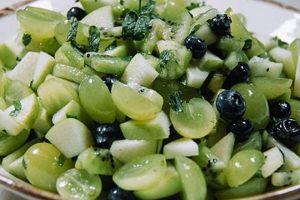Fruit salad in the Philippines represents a vibrant culinary tradition, showcasing a unique blend of tropical fruits often preserved in syrup. Common components include fruits like mangoes, papayas, pineapples, bananas, and sometimes jackfruit, guava, or nata de coco (coconut jelly). These mixtures are typically sweetened with condensed milk or sugar and served chilled, offering a refreshing treat especially popular during holidays and special occasions. Variations may incorporate other ingredients such as cheese, cream, or even fruit cocktails.
This dish reflects the country’s rich agricultural heritage and the ingenuity in preserving and enjoying its abundant produce. The refreshing nature of the dessert provides a welcome respite from the tropical heat, while the communal aspect of sharing the dish reinforces social bonds during festive gatherings. Historically, the accessibility of ingredients made it a popular dish across various socioeconomic groups, cementing its place within Filipino culinary culture.
Further exploration will delve into specific regional variations, ingredient selection, preparation techniques, and the cultural significance of this beloved dessert within Filipino cuisine.
Tips for Creating Exceptional Fruit Salad
Achieving a well-balanced and flavorful fruit salad requires careful consideration of several factors. These tips provide guidance for selecting ingredients, preparing components, and assembling the final dish.
Tip 1: Prioritize Ripe, but Firm Fruit: Opt for fruits at their peak ripeness, offering optimal sweetness and flavor. Avoid overripe fruits, as they tend to become mushy and contribute to a less appealing texture.
Tip 2: Embrace Variety in Texture and Flavor: Combine fruits with diverse textures and flavor profiles. This can involve incorporating a mix of soft fruits like bananas and mangoes with firmer options like apples or pears. Tart fruits, such as pineapple or oranges, provide a balance to sweeter elements.
Tip 3: Proper Cutting Techniques Enhance Presentation: Uniformly sized fruit pieces contribute to a more aesthetically pleasing presentation and ensure even distribution of flavors. Consider the shape and size of each fruit to determine the most appropriate cutting method.
Tip 4: Strategic Use of Preservatives: While fresh fruit is preferred, certain fruits benefit from light preservation techniques. A gentle syrup can help maintain the color and texture of easily oxidized fruits like apples or bananas.
Tip 5: Mindful Sweetener Selection: The choice of sweetener significantly impacts the overall flavor profile. Condensed milk provides a rich, creamy sweetness, while simple syrups offer a lighter touch. Adjust sweetness levels according to personal preference and the natural sweetness of the chosen fruits.
Tip 6: Chill Thoroughly Before Serving: Chilling allows the flavors to meld and enhances the refreshing quality of the salad. Allow sufficient time for the fruit to chill completely before serving for optimal enjoyment.
Tip 7: Garnishing for Visual Appeal: A simple garnish can elevate the presentation of the fruit salad. A sprig of mint, a dusting of powdered sugar, or a sprinkle of toasted coconut flakes can add an elegant touch.
By following these guidelines, one can create a fruit salad that is not only visually appealing but also delivers a delightful symphony of flavors and textures.
In conclusion, crafting a truly exceptional fruit salad involves understanding the nuances of ingredient selection, preparation techniques, and thoughtful presentation. These tips offer a foundation for creating a dish that is both refreshing and satisfying.
1. Fresh, Ripe Tropical Fruits
The foundation of any authentic Filipino fruit salad lies in the careful selection of fresh, ripe tropical fruits. The Philippines’ rich biodiversity provides a vast array of options, each contributing unique flavors and textures to the final dish. Understanding the characteristics of these fruits is essential for creating a balanced and delicious salad.
- Variety and Seasonality
Philippine fruit salad recipes often showcase the diversity and seasonality of the country’s produce. Mangoes, renowned for their sweetness, are a staple ingredient, with various cultivars like Carabao, Pico, and Indian mangoes offering distinct flavor profiles. Papayas contribute a creamy texture, while pineapples provide a tangy counterpoint. The use of seasonal fruits ensures optimal ripeness and flavor, reflecting a deep connection to agricultural cycles.
- Flavor Profiles and Combinations
Balancing sweetness, tartness, and subtle aromatic notes is crucial. The sweetness of bananas complements the tartness of pineapples, while the subtle floral notes of ripe guava add complexity. Consideration of these flavor profiles allows for the creation of harmonious combinations that enhance the overall sensory experience.
- Texture and Ripeness
Textural variation is another defining characteristic. The soft, yielding texture of ripe bananas contrasts with the firm bite of apples or the juicy burst of grapes. Proper ripeness is paramount; overripe fruit can lead to a mushy texture, while underripe fruit lacks the desired sweetness and flavor. Balancing these textures creates a more dynamic and enjoyable eating experience.
- Cultural Significance
The inclusion of specific fruits often holds cultural significance. For example, the use of mangoes, a ubiquitous symbol of Filipino hospitality, often features prominently in celebratory dishes. The presence of these fruits not only contributes to the flavor profile but also adds a layer of cultural meaning to the dish, reinforcing its role in traditions and celebrations.
The selection and combination of these fresh, ripe tropical fruits form the essence of Filipino fruit salad recipes. This emphasis on fresh, locally sourced ingredients highlights the importance of agricultural abundance and the culinary creativity in showcasing the bounty of the Philippines.
2. Sweetened Condensed Milk
Sweetened condensed milk plays a pivotal role in Filipino fruit salad recipes, contributing significantly to the distinctive flavor profile. Its inclusion stems from several factors, including historical availability, affordability, and its ability to enhance the overall sensory experience. Condensed milk acts as both a sweetener and a binding agent, creating a creamy, cohesive texture that complements the diverse array of tropical fruits typically used. This ingredient imparts a rich, caramelized sweetness distinct from granulated sugar, adding depth and complexity to the dish. For instance, its creamy texture balances the acidity of fruits like pineapples and mangoes, creating a harmonious blend of sweet and tart flavors. Furthermore, the viscosity of condensed milk helps to coat the fruit pieces, preventing oxidation and preserving their vibrant colors.
The historical context of condensed milk in the Philippines further underscores its importance. During periods when refrigeration was less accessible, condensed milk provided a shelf-stable option for sweetening and preserving food. This practicality cemented its place in Filipino cuisine, becoming a staple ingredient in various desserts, including fruit salad. This accessibility made it a popular choice across different socioeconomic groups, contributing to its widespread adoption in traditional recipes. Moreover, the creamy texture and rich flavor of condensed milk enhance the overall palatability of the fruit salad, making it a beloved treat enjoyed across generations.
Understanding the significance of sweetened condensed milk in Filipino fruit salad recipes provides valuable insight into the evolution of Filipino cuisine. Its role extends beyond mere sweetness, contributing to texture, preservation, and cultural heritage. This knowledge allows for a deeper appreciation of the dish and informs culinary choices in both traditional and contemporary preparations. While alternative sweeteners exist, the unique characteristics of condensed milk remain integral to the authentic flavor and cultural significance of Filipino fruit salad. Adapting recipes while retaining the essence of this traditional ingredient presents a continuing culinary challenge.
3. Chilled Serving Temperature
The practice of serving Filipino fruit salad chilled is integral to the overall sensory experience and reflects cultural adaptations to the tropical climate. A chilled temperature enhances the refreshing qualities of the dish, providing a welcome respite from the heat. This preference also contributes to food safety, particularly relevant in warmer climates where bacterial growth is a concern. Chilling further influences the perception of flavors and textures, making the dish more palatable and enjoyable.
- Enhanced Refreshment
The primary benefit of chilling Filipino fruit salad is the enhanced sensation of refreshment. The cool temperature contrasts pleasantly with the ambient heat, making the dish particularly appealing in the Philippine climate. This cooling effect contributes significantly to the enjoyment of the salad, especially during festive occasions and hot weather.
- Food Safety
Chilling plays a crucial role in maintaining food safety by inhibiting bacterial growth. Lower temperatures slow down the proliferation of microorganisms, reducing the risk of spoilage and foodborne illnesses. This is particularly important for fruit salads, which are often prepared in advance and served at room temperature for extended periods during gatherings.
- Flavor and Texture Enhancement
Chilling influences the perception of flavors and textures within the fruit salad. Cooling can dull excessive sweetness, allowing the subtle nuances of different fruits to emerge. It also firms the texture of certain fruits, contributing to a more pleasant mouthfeel. This delicate balance of flavors and textures enhances the overall sensory experience.
- Cultural Significance
The preference for chilled fruit salad aligns with broader cultural practices in the Philippines, where cold beverages and desserts are favored in the tropical climate. This preference extends beyond mere refreshment, reflecting a cultural adaptation to environmental conditions. Serving fruit salad chilled has become a customary practice, contributing to the traditional experience of consuming this dish.
The chilled serving temperature of Filipino fruit salad is thus not merely a culinary preference but a multifaceted practice intertwined with sensory experience, food safety, and cultural norms. It contributes significantly to the dish’s appeal and its enduring popularity within Filipino cuisine. Understanding this aspect provides a deeper appreciation for the cultural context and culinary wisdom behind this beloved dessert.
4. Festive Occasion Staple
Filipino fruit salad occupies a prominent place in celebratory gatherings, reflecting cultural values of hospitality, abundance, and shared enjoyment. Its presence signifies more than just a dessert; it embodies a sense of occasion and reinforces communal bonds. Understanding this connection provides insights into the socio-cultural significance of food within Filipino traditions. The following facets explore this relationship in greater detail.
- Symbol of Abundance and Prosperity
The colorful array of fruits in a Filipino fruit salad symbolizes abundance and prosperity. Generous portions and diverse ingredients reflect a desire to share good fortune and celebrate life’s blessings. This symbolism is particularly relevant during holidays like Christmas and New Year, where the fruit salad becomes an embodiment of hope for a prosperous year ahead. The vibrant presentation contributes to the festive atmosphere, visually representing the spirit of celebration.
- Communal Sharing and Hospitality
Fruit salad’s communal nature fosters a sense of togetherness. Large bowls of fruit salad, often placed at the center of the table, encourage sharing and interaction among family and friends. This shared experience strengthens social bonds and reinforces the Filipino value of hospitality. The act of partaking in the same dish symbolizes unity and collective celebration.
- Adaptability and Regional Variations
The adaptability of Filipino fruit salad recipes allows for regional and personal variations, reflecting the diverse culinary landscape of the Philippines. While core ingredients remain consistent, the inclusion of local or seasonal fruits adds a unique touch to each preparation. This adaptability ensures the dish remains relevant and appealing across different regions and family traditions. For instance, the use of specific fruits may hold symbolic meaning within certain communities, further enriching the cultural significance of the dish.
- Ease of Preparation and Accessibility
The relative ease of preparation and the accessibility of ingredients contribute to the fruit salad’s popularity during festive occasions. The simplicity of combining various fruits and a readily available sweetener like condensed milk makes it a practical choice for large gatherings. This accessibility allows families from different socioeconomic backgrounds to participate in the tradition, ensuring its inclusivity and widespread enjoyment. This practicality allows focus to remain on the celebration itself rather than complex culinary preparations.
The association of Filipino fruit salad with festive occasions underscores its cultural significance within Filipino society. It transcends its role as a simple dessert, embodying values of abundance, community, and shared joy. This connection further emphasizes the role of food in expressing cultural identity and reinforcing social bonds within the Filipino community. The continued presence of fruit salad at celebrations ensures the transmission of these values across generations.
5. Regional Variations Exist
Regional variations in Filipino fruit salad recipes demonstrate the archipelago’s diverse culinary landscape, influenced by local produce availability, cultural preferences, and historical factors. These variations highlight the adaptability of the core concept, showcasing ingenuity in utilizing readily available ingredients while maintaining the essence of the dish. Examining these regional nuances provides valuable insight into the dynamic interplay between cultural identity and culinary expression.
Luzon, the largest island in the Philippines, exhibits a broader incorporation of temperate fruits like apples and grapes, reflecting historical trade influences and cooler growing conditions in certain areas. In contrast, Visayas, the central island group, often features more indigenous fruits like durian or lanzones, showcasing the region’s unique biodiversity. Mindanao, the southernmost major island, incorporates ingredients like marang or chempedak, reflecting its proximity to Southeast Asia and distinct culinary traditions. These distinctions extend beyond fruit selection, encompassing variations in sweeteners, additions like cheese or cream, and even preferred levels of sweetness. For example, some regions might favor the use of coconut milk or kaong (sugar palm fruit) alongside the more common condensed milk, resulting in distinct flavor profiles. The preparation methods also vary; certain regions prefer dicing fruits uniformly, while others embrace larger, more rustic cuts.
Understanding these regional variations provides a deeper appreciation for the dynamic nature of Filipino cuisine. It challenges the notion of a singular, static recipe, emphasizing the ongoing evolution of culinary traditions shaped by geographical and cultural factors. Recognizing these nuances allows for a more informed exploration of Filipino food culture and encourages culinary creativity in adapting recipes based on available ingredients and personal preferences. This awareness ultimately contributes to a richer understanding of the dish and its significance within the broader context of Filipino culinary heritage.
Frequently Asked Questions
This section addresses common inquiries regarding Filipino fruit salad recipes, providing clarity on ingredient selection, preparation techniques, and cultural context.
Question 1: What distinguishes Filipino fruit salad from other fruit salads?
The distinctive use of sweetened condensed milk, the emphasis on tropical fruits, and the chilled serving temperature differentiate Filipino fruit salad. The cultural significance associated with festive occasions further distinguishes it.
Question 2: Can alternative sweeteners be used in place of condensed milk?
While alternative sweeteners like syrup or honey can be used, they alter the authentic flavor profile. Condensed milk contributes a specific richness and creaminess integral to the traditional recipe.
Question 3: How does one prevent fruit discoloration in the salad?
The condensed milk itself offers some protection against oxidation. Additionally, a light coating of fruit juice, such as lemon or pineapple juice, can help preserve the vibrant colors of easily oxidized fruits.
Question 4: Are there regional variations in fruit selection?
Regional variations exist, reflecting local produce availability and culinary traditions. Certain regions might incorporate indigenous fruits specific to their area, showcasing the diversity of Philippine produce.
Question 5: What is the significance of serving the salad chilled?
The chilled temperature enhances the refreshing quality of the salad, particularly beneficial in the Philippine climate. It also contributes to food safety by inhibiting bacterial growth.
Question 6: Can canned fruits be used in Filipino fruit salad?
While fresh fruit is preferred for optimal flavor and texture, canned fruits can be used in situations where fresh options are limited. Ensure canned fruits are drained properly to prevent excess syrup from affecting the overall balance of the salad.
Careful consideration of these frequently asked questions enhances understanding and facilitates successful preparation of authentic and enjoyable Filipino fruit salad.
The next section will explore specific recipes and variations, offering practical guidance for creating this beloved Filipino dish.
Filipino Fruit Salad Recipes
Filipino fruit salad recipes represent more than a simple dessert; they embody a rich tapestry of cultural traditions, agricultural heritage, and culinary ingenuity. From the careful selection of fresh, ripe tropical fruits to the characteristic sweetness imparted by condensed milk, each element contributes to a dish that is both refreshing and symbolically significant. The chilled serving temperature, the prominence at festive gatherings, and the regional variations underscore the dish’s adaptability and enduring appeal across generations and geographical boundaries. An understanding of these facets provides a deeper appreciation for the dish’s place within Filipino culinary identity.
Exploration of these recipes offers a valuable lens through which to understand the dynamic interplay between food and culture in the Philippines. Continued appreciation and adaptation of these traditions ensure the preservation of culinary heritage for future generations. Further research into specific regional variations and the evolving use of ingredients promises to enrich the understanding and enjoyment of this beloved Filipino classic.






